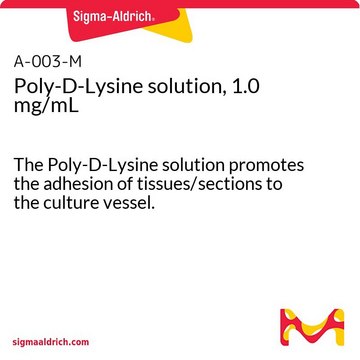P7405
Poly-ᴅ-Lysine Hydrobromide
synthetic, mol wt >300,000, powder, γ-irradiated, suitable for cell culture, BioXtra
Synonym(s):
PDL
About This Item
Recommended Products
Product Name
Poly-D-lysine hydrobromide, mol wt >300,000, lyophilized powder, γ-irradiated, BioReagent, suitable for cell culture
biological source
synthetic (chemical)
Quality Level
sterility
γ-irradiated
product line
BioReagent
BioXtra
form
lyophilized powder
mol wt
>300,000
packaging
pkg of 5 mg
concentration
0.016—0.032 mmol lysine
technique(s)
cell culture | mammalian: suitable
surface coverage
4 μg/cm2
solubility
H2O: soluble 50 mg/mL, clear, colorless
shipped in
ambient
storage temp.
−20°C
SMILES string
O=C(C)[C@@](NC)([H])CCCCN.[Br]
InChI
1S/C6H14N2O2.BrH/c7-4-2-1-3-5(8)6(9)10;/h5H,1-4,7-8H2,(H,9,10);1H
InChI key
MEXAGTSTSPYCEP-UHFFFAOYSA-N
Looking for similar products? Visit Product Comparison Guide
General description
Application
- in preparing the surface of coverslips for cell attachment
- in coating glass-bottom dishes for live cell imaging of primary cortical neuronal cells
- in coating 24-well plates for the isolation of primary astrocytes to study the impact of melanoma-derived exosomes on the reprogramming of stromal cells within the metastatic microenvironment
- for coating 16-well chamber slides to study the effects of maternal immune activation on behavioral impairments and alterations in cytokine and synaptic protein expression in the cerebellum
This product is recommended as a cell culture substratum when using 0.5 - 1.0 mL of a 0.1 mg/mL solution to coat 25 cm2. Lower molecular weight versions of the product are less viscous, but high more molecular weight versions provide more attachment sites per molecule.
Biochem/physiol Actions
Components
Caution
Analysis Note
Storage Class Code
11 - Combustible Solids
WGK
WGK 3
Flash Point(F)
Not applicable
Flash Point(C)
Not applicable
Personal Protective Equipment
Choose from one of the most recent versions:
Already Own This Product?
Find documentation for the products that you have recently purchased in the Document Library.
Customers Also Viewed
Articles
Extracellular matrix proteins such as laminin, collagen, and fibronectin can be used as cell attachment substrates in cell culture.
Protocols
Poly-L-Lysine Cell Attachment Protocol
Our team of scientists has experience in all areas of research including Life Science, Material Science, Chemical Synthesis, Chromatography, Analytical and many others.
Contact Technical Service






